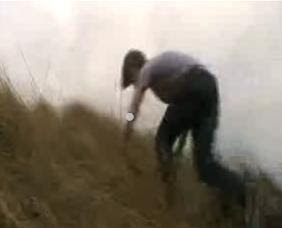the correct side.

This is a example of where we used the technique "Flop" in our piece, notice the watch has switched hands.
From our preliminary task we also learnt basic editing skills such as adding footage to the footage pool and using simple editing techniques to put together a small sequence, we used these simple techiques for our main task but we also used new techniques which we did not in the preliminary task.
One of the skills we have gained from our main task was our managment of sound. In our preliminary task there was no ambient noise as we were inside but in our main task we had to deal with the wind and adding a soundtrack to our piece. We dealt with the added challenge of the wind on the beach by reducing the sound on the footage so we could hardly hear it as it changed between shots we thought this was the best option we had. We also had to add the soundtrack which we had created using "Garageband". This was effective in our piece as it helped mask the wind noise and adding the sad atmosphere to the piece, our voiceover which we recorded and added also helped with this. We didn't have a voiceover in our preliminary task so we learnt how to record this and save it onto the computer using "Soundtrack Pro" for our main task.
For the filming of our project we used some more difficult camera angles and shots. We felt this was neccesary to ensure our piece looked authentic and wasn't boring. We used different shot angles when we were on the beach such as a low angle shot when the character is climbing up one of the sad dunes, as it makes the sand dune seem steeper than it actually was. In our preliminary task we noticed the filming was quite fast paced this was mainly due to our camera being still when filming and having to use lots of cuts to show what we wanted. In our main task we solved this by using "Pan Shots" which track the characters movements rather than cutting to another shot. We also used slow blurs on our titles both of which were not in our preliminary task.
From doing our main task as a group we are not as naive about filming times and know it some times takes quite a while to get the desired shot and sometimes it is not enough to do one take of each shot. Also we have learnt to be more adventourous with our filming rather than doing simple still shots.


















